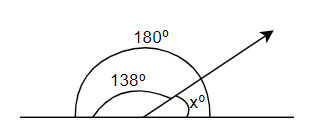
Find the measure of the supplementary angle pair of $ 138{}^\circ $ . (in degrees)
Answer
489.6k+ views
Hint: Supplementary angles means those angles where the sum of the angles is equal to $ 180{}^\circ $ . We have to find the pair of angles, which includes an angle of $ 138{}^\circ $ and whose sum is $ 180{}^\circ $ . WE can do so by assuming the unknown pair as X and forming an equation with the known angle so that their sum is equal to $ 180{}^\circ $ .
Complete step-by-step answer:
It is given in the question that we have to find the measure of the supplementary angle pair of $ 138{}^\circ $ . As we know, supplementary angles are basically a pair of angles, where the sum of the pair of the angles is equal to $ 180{}^\circ $ or we can say $ x+y=180{}^\circ $ . Now, to solve this question , let us assume the unknown angle as X. The other angle is known to us, that is, $ 138{}^\circ $ . So, it means that the sum of X and $ 138{}^\circ $ should be equal to $ 180{}^\circ $ .

So, we can write it as follows,
$ X+138{}^\circ =180{}^\circ $
Now, we will transpose $ 138{}^\circ $ from the left hand side or the LHS to the right hand side or the RHS, So, we will get,
$ \begin{align}
& X=180{}^\circ -138{}^\circ \\
& \Rightarrow X=42{}^\circ \\
\end{align} $
Therefore, the angle X is equal to $ 42{}^\circ $ and the supplementary pair of angles is $ \left( 138{}^\circ ,42{}^\circ \right) $ .
Note: There is a possibility that the students get confused with complementary and supplementary angles. If they are not clear of this basic concept, then they might get the incorrect answer. We can apply a simple trick to easily remember the meaning of complementary and supplementary angles, which is as follows : We know that alphabet C comes before S and that $ 90{}^\circ $ comes before $ 180{}^\circ $ , so we can memorise it as follows, $ C-90{}^\circ $ and $ S-180{}^\circ $ or as $ C
Complete step-by-step answer:
It is given in the question that we have to find the measure of the supplementary angle pair of $ 138{}^\circ $ . As we know, supplementary angles are basically a pair of angles, where the sum of the pair of the angles is equal to $ 180{}^\circ $ or we can say $ x+y=180{}^\circ $ . Now, to solve this question , let us assume the unknown angle as X. The other angle is known to us, that is, $ 138{}^\circ $ . So, it means that the sum of X and $ 138{}^\circ $ should be equal to $ 180{}^\circ $ .

So, we can write it as follows,
$ X+138{}^\circ =180{}^\circ $
Now, we will transpose $ 138{}^\circ $ from the left hand side or the LHS to the right hand side or the RHS, So, we will get,
$ \begin{align}
& X=180{}^\circ -138{}^\circ \\
& \Rightarrow X=42{}^\circ \\
\end{align} $
Therefore, the angle X is equal to $ 42{}^\circ $ and the supplementary pair of angles is $ \left( 138{}^\circ ,42{}^\circ \right) $ .
Note: There is a possibility that the students get confused with complementary and supplementary angles. If they are not clear of this basic concept, then they might get the incorrect answer. We can apply a simple trick to easily remember the meaning of complementary and supplementary angles, which is as follows : We know that alphabet C comes before S and that $ 90{}^\circ $ comes before $ 180{}^\circ $ , so we can memorise it as follows, $ C-90{}^\circ $ and $ S-180{}^\circ $ or as $ C
Recently Updated Pages
What is the degree of the angle at 6 oclock-class-8-maths-CBSE

Bad effects of various festivals on the environment class 8 chemistry CBSE

How would you describe a globe class 8 physics CBSE

Whats the square root of 3721 class 8 maths CBSE

A container has a capacity of 300 litres If the liquid class 8 maths CBSE

A colour TV is available for Rs 13440 inclusive of class 8 maths CBSE

Trending doubts
You want to apply for admission into a prestigious class 8 english CBSE

How many ounces are in 500 mL class 8 maths CBSE

When will we use have had and had had in the sente class 8 english CBSE

Change He keeps me waiting to passive voice class 8 english CBSE

The Chinese traveller FaHien visited India and left class 8 social science CBSE

State the differences between manure and fertilize class 8 biology CBSE





